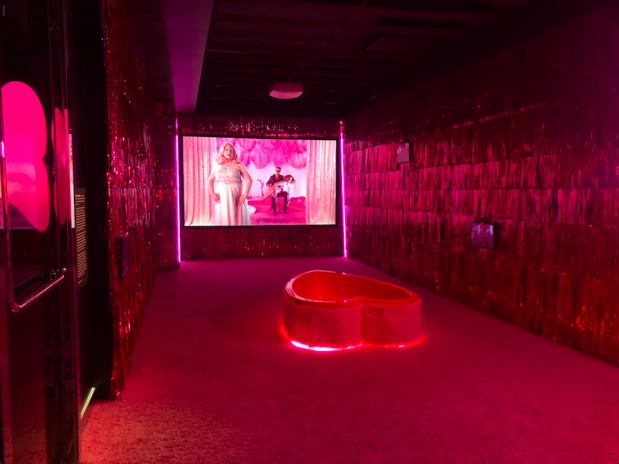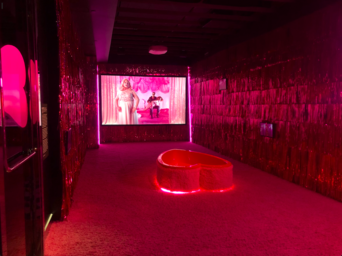What comes to mind when you hear the words “visual pleasure”? Installed at the Museum of Fine Arts Boston in June, contemporary artist Samantha Nye’s visual pleasure video series reimagines 60’s-era scopitone films in a way that showcases and celebrates femme queer and nonbinary love, intentionally using older women and femmes as her muses. This unique and interactive modern exhibit will unfortunately close at the end of October.
In her own words, Samantha Nye’s installation is “a peep show for aging lesbians, a dance party, and a DIY honeymoon suite.” Tucked into Gallery 264, the installation itself is placed right next to the Claude Monet exhibit, creating a juxtaposition of classic and modern that only adds to Nye’s queer celebration. The gallery is lit entirely in purple and pink, and the walls are covered by shiny magenta fringe. It’s truly a sight to behold, particularly within an institution like the MFA. Nye’s visual pleasure video series is projected onto the opposite wall and plays on a continuous loop. The videos are offset by the campy, hot pink setting of the exhibition itself, complete with a heart shaped bathtub stationed in the middle of bright pink shag carpet.he whole room is reminiscent of a cheesy, 70’s hotel room.
The videos themselves are redesigned versions of classic 60’s scopitones, which were the precursors for music videos. Nye takes much of her inspiration from Susan Sontag’s “Notes on Camp” essay, where she originally heard the term “scopitone”. Starring Nye, herself, alongside her mother, her grandmother, and their circle of older friends. Nye’s decision to cast older women, and notably her own matrilineage, comes from her desire to play on certain Freudian themes saying her casting choices are “a visual way to poke at the symbiosis that is expected in mother-daughter relationships. Idioms such as ‘you are the spitting image of your mother’ or ‘like mother like daughter’ are so fraught and funny to me. Playing with a queer psychoanalytic lens, I was thinking specifically about falling in love with one’s own image and taking that to a theatrical extreme. I am my mother and her love interest; she is me and mine.”
Despite their influence and importance, older members of the queer community are rarely given the attention and media representation they deserve. Nye set to correct this by recreating the music videos and visual projects that would have been a staple in her models’ lives in their youth; vintage stars like Julie London and Neil Sedaka were used as inspiration. By allowing her older models to play with seduction and desire, she aims to let them act within a fantasy that would have been impossible in their youth. In this way, they get to experience “young” queer culture in ways that were not previously acceptable. In an interview with Bomb Magazine, Nye speaks on her motivation for the stars of her visual art saying, “I want to create a world that gets sexier with age”. There’s something almost hypnotizing about the bubblegum pink aesthetic about Nye’s videos and installation, alongside BDSM and butch lesbian “leather daddies” that would make the common museum-goer blush.
As much as I love sitting inside the installation, sitting outside Gallery 264—observing the reactions of the people entering and exiting the exhibit—proves to be just as interesting. I notice so many museum-goers—mainly men and older straight couples—approaching the door before turning away and walking down the museum corridor like they were pretending to not have seen it at all. The walls of the room are blacked out, with a hot pink door, and a sign outside that reads: “The video artwork within this gallery explores the sexuality and eroticism of women and nonbinary people. These are common themes in art history, although we hope if you spend time with the work you will understand how this artwork is radically different, too.” To some, it feels like an invitation; to others, a warning. Because Nye’s work is such a step away from something you would normally see in an encyclopedic collection like the MFA, it’s important that we reflect on what—or who—we as a culture deem worthy of being on display. Millar Fisher, the museum’s curator of contemporary decorative arts, spoke on this topic in an interview with the Boston Globe: “There are places where it’s OK to inhabit your full identity and think about desire in that way. A museum Is not usually one of them.”
Is the Samantha Nye installation designed to make you feel uncomfortable? I think it depends on your perspective. If the imagery of her videos makes you uneasy, I invite you to examine why. When so much of our cultural media revolves around heterocentrism, it’s easy to feel a little jolted when we’re confronted with something that rejects those images and ideas. To those within our community that seldom see themselves reflected in mainstream media, seeing queer and femme love represented onscreen can be a great comfort. Similarly, the LGBTQ+ representation we do see in the media is heavily skewed towards youth; Nye observes this especially within the social media sphere. These two subjects often go hand in hand; our society in general has an obsession with youth and beauty which ties into the idealization of heteronormative culture. Hopefully, art like Nye’s being put further into the mainstream can give a bigger platform to these much-needed depictions of mature queer love.
Samantha Nye’s “My Heart’s In A Whirl” is open at the Museum of Fine Arts until October 31, 2021. One of her paintings, “Attractive People Doing Attractive Things in Attractive Places- Double Your Pleasure – Double Your Pleasure” is on display in the “New Light: Encounters and Connections” exhibit of the museum. To see more of her work, click here.


